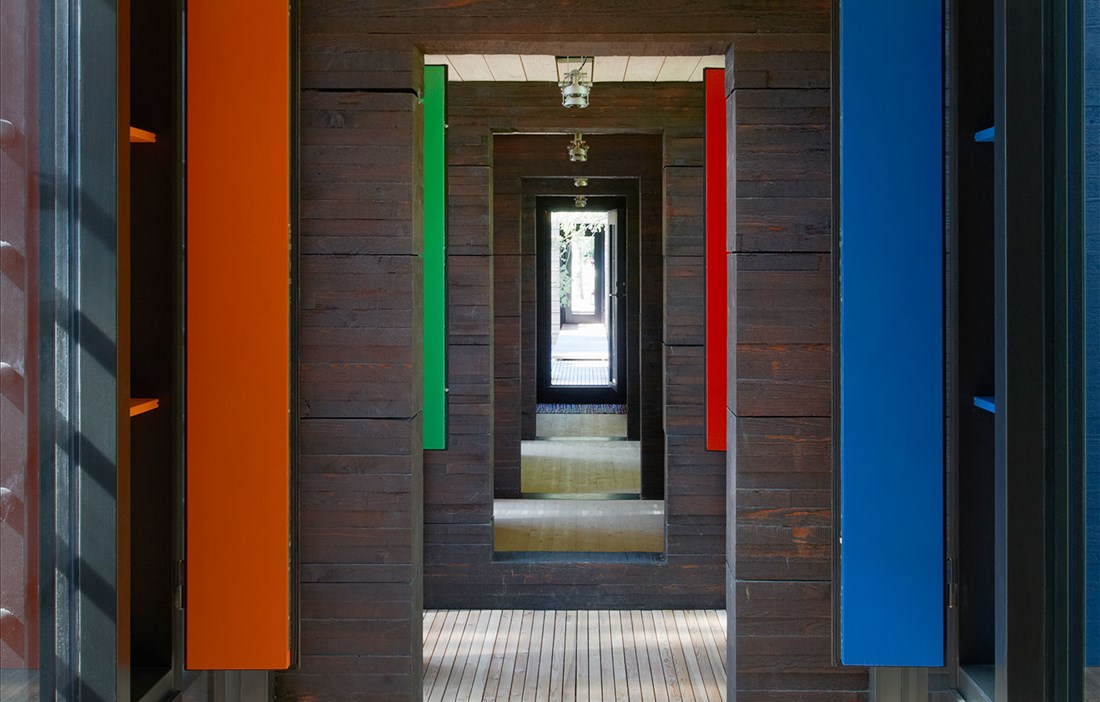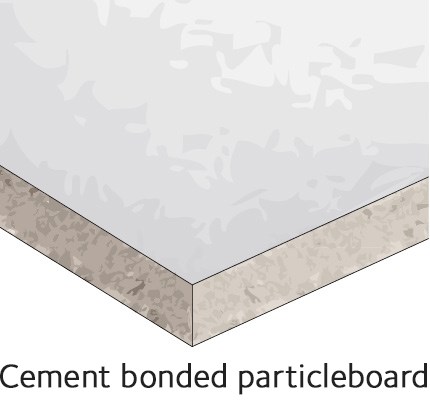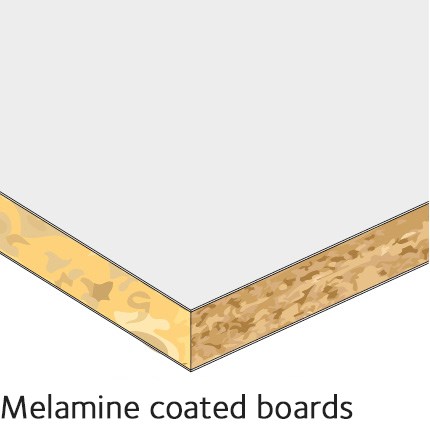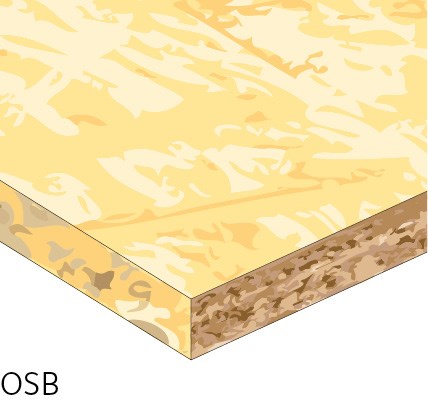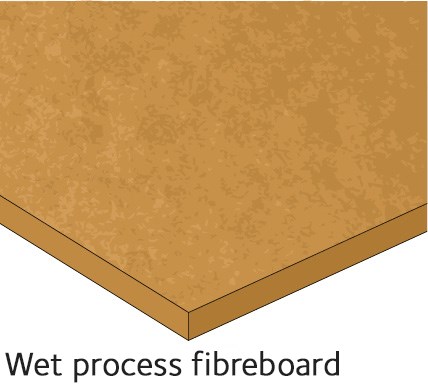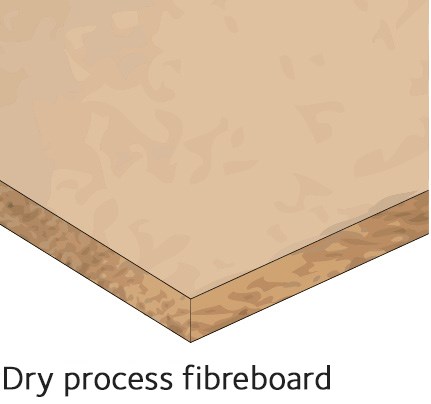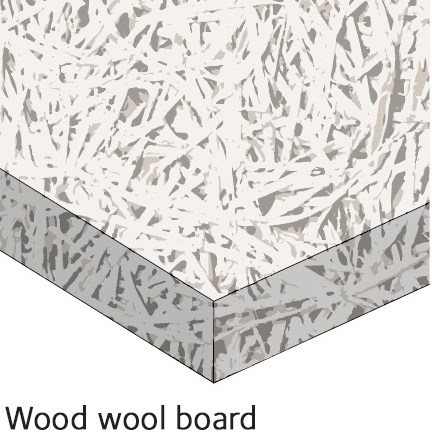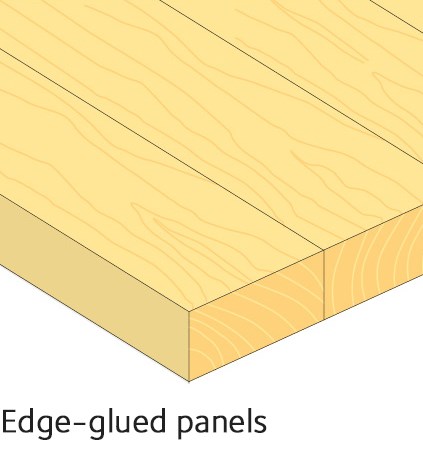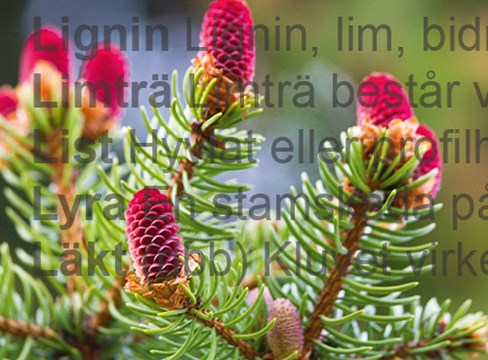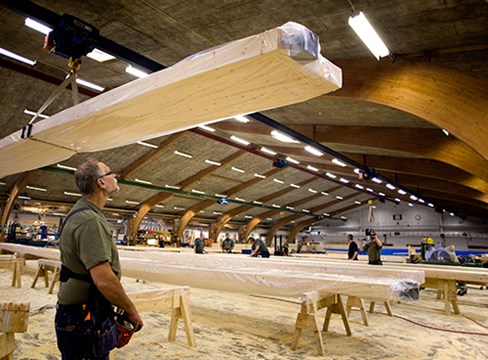Sheet materials
Wood-based sheet materials are versatile products for construction and interiors. In buildings, sheet materials are used for flooring, walls and roofs. They are also used in furniture, with thinner sheets used as the back panel of bookshelves to provide rigidity, for example. In interiors, sheet materials can be used for the sides and doors of cupboards and are also used as countertops. The sheets are made from wood material in the form of staves, veneers, particles or fibres. The sheets are manufactured to various standards. For CE marked construction panels, the main purpose is shown on the label (floor, wall or roof).
Plywood
Plywood is made up of an odd number of thin veneers bonded together. The veneer layers are laid at right angles to each other. The veneer is obtained through slicing or rotary cutting. The way in which the veneer is produced plays an important role in determining the pattern of the wood, which is crucial to the final appearance. The pattern of growth rings or other fibre distortions (imperfections) in the wood material give it character. Some types of plywood are coated with a thin surface layer of melamine or plastic impregnated paper (formwork plywood). A printed pattern on the paper can give the character of different wood types. Veneers with sawn knots provide great variation on the surfaces. In some grades, any knot holes are filled to give a smooth surface. Plywood sheets are usually much stiffer and stronger in one direction, a property that is exploited during use. Due to its composition, plywood is a material that can be sawn into any shape. Plywood is usually bonded with a phenolic resin glue, which is in principle a waterproof glue. Plywood can therefore be used for casting and for façades, roofs, boats and caravans. For some of these uses specialist grades will be required.
Formwork plywood is designed for use in shuttering for concrete casting. Both sides of the sheet have a completely smooth veneer surface that is coated with a layer of plastic impregnated paper. Formwork plywood also has many other applications, for example in agriculture, transport (for trailer floors) and signage. A non-slip surface can be created by embossing a pattern in the outer layer.
Grades and labelling of plywood
The designations B, BB and X are used for pine plywood and hardwood plywood.
B represents a surface with only very small knots. Small knot holes and splits in the veneer are filled, before the surface is polished.
X represents a surface that may have a large number of (possibly large) knots, knot holes and splits. BB is a grade between B and X.
Structural plywood and construction plywood have designations according to ISO and European standards and US rules. The standards include a class E, which in practice stands for knot-free veneer surfaces. The standards then classify the surfaces using the Roman numerals I, II, III and IV.
I is the class with the least knots and knot holes. A summarising designation for both the front and back might thus be II/III. US rules apply the classes A, B, C and D (with rising levels of permitted knots). A P in the designation states that knot holes and splits have been repaired with filler to create a smooth surface. A summarising designation for both the front and back might thus be CPC.
Structural plywood is manufactured to specific rules in strength classes P40, P30 and P20. P30 is the most common. While in theory P30 only refers to the strength, in practice it has also come to stand for a particular character in the outer veneer.
Particleboard
Particleboard is manufactured in a continuous production line, where layers of fine particles and coarser chips are coated in glue, layered, compressed and hardened with the application of heat. The fine particles give the finished product a surface suitable for finishing with paint, for example. Due to a process whereby particles are sprinkled on a conveyor and partially align themselves in the direction of travel, particleboard has slightly different properties along its width and its length. The most common glue for particleboard is carbamide glue (urea). Particleboard is used in applications such as subfloors, walls, ceilings, furniture and interior fittings.
Particleboard is given a designation according to its intended use, e.g. furniture, construction, flooring, ceiling, etc. For historical reasons, the designation of particleboard’s moisture resistance is split into V20 and V313. V313 is the moisture resistant type. The European standard for particleboard divides the boards into classes P1–P7 according to their intended use. Types P1 and P2 are intended for general use and for interior fittings and furniture in dry environments. Type P3 is similar, but in damper surroundings. Types P4–P7 can be put to various uses in load-bearing structures under Eurocode 5.
Cement bonded particleboard
In cement bonded particleboard, the wood particles are bound together with cement. Particular properties of such boards include resistance to fire and microbial degradation. Cement bonded particleboard is described according to its intended use, any colouring, the surface properties and the shape and edge profile of the board. Boards can be specially manufactured for use in wet rooms or on façades.
Melamine coated boards
The melamine layer on coated boards is made by compressing several layers of paper impregnated with plastic and applying heat to harden it. This creates a very thin surface layer. The thin melamine layer provides a durable surface for decorative effects. The most common combination is a melamine layer on particleboard. Moisture-related movements can vary a little between the particleboard and the melamine layer, which is why it is best that both sides of the particle board are coated. If just one side is coated, the board may warp. Melamine coated boards are used in applications such as furniture and interior fittings.
OSB
OSB (Oriented Stranded Board) is recognisable for the large flat wood shavings that are visible on the surface. These boards are particularly resistant to corner breakage. Just like with plywood, OSB has a clear main direction. The shavings near the surface align with the length of the board, while the shavings in the middle are aligned at 90 degrees. The shavings may be softwood or hardwood. The glue may be phenolic resin glue in powder form or melamine glue. OSB is used in applications such as walls and packaging.
It is available in types 1, 2, 3 and 4. Type OSB/1 is for general use and for interior fittings in a dry environment. Type 4 is the heaviest and most moisture resistant. Types OSB/2 to OSB/4 can be put to various uses in load-bearing structures under Eurocode 5.
Wet process fibreboard
Wet process fibreboard (masonite) is manufactured from fibres extracted from the wood with the help of strong heat treatment, grinding or refining. The fibres are suspended in water and pumped onto a wire screen, where the water drains off. Different levels of pressure then create boards with different properties, from soft to hard. The fibres are usually held together with the adhesive substances that occur naturally in the wood, along with small quantities of phenolic resin glue. Hard fibreboard has a distinctive smooth front and a back with patterns from the wire screen that were carried into the press. The boards are heat-treated and some are finished with oil before the heat treatment.
Wet process fibreboard is divided into three main types: soft, medium and hard.
Dry process fibreboard
Medium Density Fibreboard (MDF) is a dry process fibreboard. The base material is dry fibres bonded using carbamide glue. MDF is an almost fully homogeneous material. It also has very consistent properties, for example when it comes to painting. Decorative grooves milled into a kitchen cupboard door will have the same paint absorption in all directions. MDF is used in applications such as furniture and interior fittings.
It comes with various levels of moisture resistance, and may also be flexible or veneered.
Wood wool board
Wood wool board is manufactured using wood wool that is bonded with cement. The cement hardens chemically with water. Wood wool comprises wood shavings half a metre long and a couple of millimetres thick that are planed from roundwood. Wood wool board has particularly good properties when it comes to sound absorption and fire resistance. The boards are used in ceilings or in acoustic barriers as a sound absorber. Wood wool is an open-structured material that allows air and moisture to be transported.
The boards are described according to their use, their colour and the finish across the width of the board, for example ceiling, white, fine planed.
Edge-glued panels
Edge-glued panels are made up of dried solid wood. The panels comprise 40–45 mm wide wood laminates that are glued together. The glue is water-based. The panels are smoothed, polished and dried. Edge-glued panels are used in applications such as countertops and shelving.
Blockboard
Blockboard is essentially an edge-glued panel that is reinforced with symmetrically bonded veneer or fibreboard. For bookshelves, blockboard gives the load-bearing capacity of the edge-glued panel and the appearance and surface properties of the veneer or hard fibreboard.
Blockboard is described according to the base material (pine staves for example) and the type of surface layer (veneer, fibreboard, melamine). An example is “laminboard” where board is used to mean wet process fibreboard.

